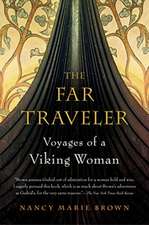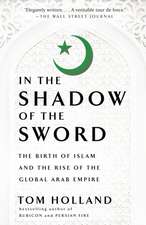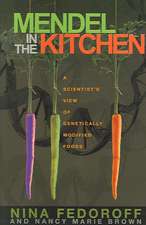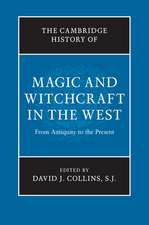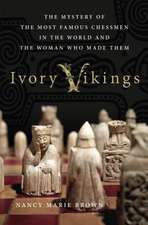The Abacus and the Cross: The Story of the Pope Who Brought the Light of Science to the Dark Ages
Autor Nancy Marie Brownen Limba Engleză Paperback – oct 2012 – vârsta de la 13 ani
The
medieval
Catholic
Church,
widely
considered
a
source
of
intolerance
and
inquisitorial
fervor,
was
not
anti-science
during
the
Dark
Ages—in
fact,
the
pope
in
the
year
1000
was
the
leading
mathematician
and
astronomer
of
his
day.
Called
“The
Scientist
Pope,”
Gerbert
of
Aurillac
rose
from
peasant
beginnings
to
lead
the
church.
By
turns
a
teacher,
traitor,
kingmaker,
and
visionary,
Gerbert
is
the
first
Christian
known
to
teach
math
using
the
nine
Arabic
numerals
and
zero.
InThe
Abacus
and
the
Cross,
Nancy
Marie
Brown
skillfully
explores
the
new
learning
Gerbert
brought
to
Europe.
A
fascinating
narrative
of
one
remarkable
math
teacher,The
Abacus
and
the
Crosswill
captivate
readers
of
history,
science,
and
religion
alike.
Preț: 156.15 lei
Nou
Puncte Express: 234
Preț estimativ în valută:
29.88€ • 31.26$ • 24.82£
29.88€ • 31.26$ • 24.82£
Carte disponibilă
Livrare economică 12-26 martie
Livrare express 26 februarie-04 martie pentru 24.82 lei
Preluare comenzi: 021 569.72.76
Specificații
ISBN-13: 9780465031443
ISBN-10: 0465031447
Pagini: 328
Ilustrații: 24 B&W photos, maps
Dimensiuni: 149 x 248 x 22 mm
Greutate: 0.39 kg
Ediția:First Trade Paper Edition
Editura: BASIC BOOKS
Colecția Basic Books
ISBN-10: 0465031447
Pagini: 328
Ilustrații: 24 B&W photos, maps
Dimensiuni: 149 x 248 x 22 mm
Greutate: 0.39 kg
Ediția:First Trade Paper Edition
Editura: BASIC BOOKS
Colecția Basic Books
Notă biografică
Nancy
Marie
Brownis
the
author
ofThe
Far
Traveler:
Voyages
of
a
Viking
WomanandMendel
in
the
Kitchen,
named
one
of
the
Best
Sci-Tech
Books
of
2004
byLibrary
Journal.
She
lives
in
Vermont.
Recenzii
Jeff
Sypeck,
author
ofBecoming
Charlemagne
“A pleasure to read,The Abacus and the Crossdraws readers into a world of intrigue, superstition, and scholarship. Nancy Marie Brown writes lucidly about math and science, finding important stories in the lives of medieval people who deserve to be widely remembered.”
Kirkus
“A thoroughly engrossing account of the Dark Ages and one of its Popes, both far less dark than popular histories teach.... The years around 1000 CE seem to be every medieval historian's favorite era, but Brown's welcome addition to the genre provides a lively, eye-opening portrait of a sophisticated Europe whose intellectual leaders showed genuine interest in learning.”
Science Writers Magazine
“As she reconstructs the strangely illuminated Europe of the Dark Ages, Brown reminds readers that the major conflicts in our world today—between Christianity and Islam, between religion and science—are products of our own age, not historical inevitabilities.”
Booklist
“As readably knowledgeable about Gerbert's political fortunes as about his intellectual influence, Brown is a lively narrator and interesting interpreter of Gerbert's life and world. This portrait gives both the science and the history audiences something to talk about.”
Richard Rubenstein, author of Aristotle's Children: How Christians, Muslims, and Jews Rediscovered Ancient Wisdom and Illuminated the Middle Ages
“The Abacus and the Crosstells the fascinating, little known story of the ‘Scientist-Pope' Sylvester II (Gerbert of Aurillac), whom older writers long considered a practitioner of the Black Arts. In this vividly presented, scrupulously researched biography, Nancy Marie Brown shows how a few open-minded intellectuals illuminated the Dark Ages by importing scientific knowledge and methods into Christian Europe from Muslim Spain. Brown's descriptions of Gerbert's ‘magical' instruments, the abacus, celestial spheres, and astrolabe, as well as of his worship of a mathematically-inspired Creator, make important contributions to the history of medieval science.”
The New York Journal of Books
“Ms. Brown's easily readable history draws the reader into a world of political intrigue, the excitement of introducing the abacus and astrolabe to Europe, and the shaky ground that surrounding the broader culture of Europe around 1000. Her book is a useful reminder that clear and well-reasoned history is by no means simplistic. The story of d'Aurillac's life and papacy shows a medieval milieu more complex than oft portrayed.”
Maria Rosa Menocal, author of The Ornament of the Worldand co-author of The Arts of Intimacy
“Overflowing with illuminating material,The Abacus and the Crossis the biography of a vital moment we know precious little about: the second half of the tenth century, when Gerbert of Aurillac, the man who would be pope at the much-anticipated millennium, came of age. Among Brown's many virtues is her ability to weave the intellectual and the material into a seamless narrative, so that when her readers learn about what books the monks of a monastery might be copying—and how those volumes connect to the intellectual past and future—they are also going to learn the mechanics of the copying itself, beginning with the cultivation of the animals whose skins will become parchment. She has the scientist's eye for detail and the historian's gift of storytelling and she has not one but dozens of great stories to tell about this transformative moment in Latin Christendom, as it began to embrace the foundations of modern science and technology.”
Library Journal
“A rags-to-riches saga…captures how the direction of history can be influenced by one person.... Had Gerbert lived longer and been more politically savvy, Brown's portrait makes one believe his ability to teach might have jump-started science before the Dark Ages enveloped Europe. VERDICT: Enjoyable to read, informative, and highly recommended for all history and history of science buffs.”
“A pleasure to read,The Abacus and the Crossdraws readers into a world of intrigue, superstition, and scholarship. Nancy Marie Brown writes lucidly about math and science, finding important stories in the lives of medieval people who deserve to be widely remembered.”
Kirkus
“A thoroughly engrossing account of the Dark Ages and one of its Popes, both far less dark than popular histories teach.... The years around 1000 CE seem to be every medieval historian's favorite era, but Brown's welcome addition to the genre provides a lively, eye-opening portrait of a sophisticated Europe whose intellectual leaders showed genuine interest in learning.”
Science Writers Magazine
“As she reconstructs the strangely illuminated Europe of the Dark Ages, Brown reminds readers that the major conflicts in our world today—between Christianity and Islam, between religion and science—are products of our own age, not historical inevitabilities.”
Booklist
“As readably knowledgeable about Gerbert's political fortunes as about his intellectual influence, Brown is a lively narrator and interesting interpreter of Gerbert's life and world. This portrait gives both the science and the history audiences something to talk about.”
>Keith
Devlin,
Stanford
University
professor
and
author
ofFibonacci's
Bridge
of
Numbers:
the
Medieval
Visionary
and
the
Book
that
Launched
the
Modern
World
“Nancy Marie Brown's book provides a fascinating, well researched, in depth study of the life and times of one of the key figures who brought modern arithmetic into Western Europe.”
Marilyn Yalom, author ofBirth of the Chess Queen
“This book will change how you think about the so-called Dark Ages. Well-researched, well-written, and vividly illuminating.”
Pat Shipman, Professor of Anthropology at the Pennsylvania State University and author ofFemme Fatale: Love, Lies, and the Unknown Life of Mata Hari
“Nancy Marie Brown again uses her extraordinary ability to bring medieval time to life inThe Abacus and the Cross, in the person of the ‘Scientist Pope' Gerbert of Aurillac (later Pope Sylvester II). Working from sparse records, Brown manages to tell us of the remarkable scholar, brilliant mathematician, and inveterate punster who loved both his holy orders and luxurious living. She shows us a time in which the route to God lay through the study of science and math and when intellectual developments flowed across the boundaries of religion and empire in Eurasia. This is a remarkable book that reflects on our modern times on every page.”
“Nancy Marie Brown's book provides a fascinating, well researched, in depth study of the life and times of one of the key figures who brought modern arithmetic into Western Europe.”
Marilyn Yalom, author ofBirth of the Chess Queen
“This book will change how you think about the so-called Dark Ages. Well-researched, well-written, and vividly illuminating.”
Pat Shipman, Professor of Anthropology at the Pennsylvania State University and author ofFemme Fatale: Love, Lies, and the Unknown Life of Mata Hari
“Nancy Marie Brown again uses her extraordinary ability to bring medieval time to life inThe Abacus and the Cross, in the person of the ‘Scientist Pope' Gerbert of Aurillac (later Pope Sylvester II). Working from sparse records, Brown manages to tell us of the remarkable scholar, brilliant mathematician, and inveterate punster who loved both his holy orders and luxurious living. She shows us a time in which the route to God lay through the study of science and math and when intellectual developments flowed across the boundaries of religion and empire in Eurasia. This is a remarkable book that reflects on our modern times on every page.”
Richard Rubenstein, author of Aristotle's Children: How Christians, Muslims, and Jews Rediscovered Ancient Wisdom and Illuminated the Middle Ages
“The Abacus and the Crosstells the fascinating, little known story of the ‘Scientist-Pope' Sylvester II (Gerbert of Aurillac), whom older writers long considered a practitioner of the Black Arts. In this vividly presented, scrupulously researched biography, Nancy Marie Brown shows how a few open-minded intellectuals illuminated the Dark Ages by importing scientific knowledge and methods into Christian Europe from Muslim Spain. Brown's descriptions of Gerbert's ‘magical' instruments, the abacus, celestial spheres, and astrolabe, as well as of his worship of a mathematically-inspired Creator, make important contributions to the history of medieval science.”
The New York Journal of Books
“Ms. Brown's easily readable history draws the reader into a world of political intrigue, the excitement of introducing the abacus and astrolabe to Europe, and the shaky ground that surrounding the broader culture of Europe around 1000. Her book is a useful reminder that clear and well-reasoned history is by no means simplistic. The story of d'Aurillac's life and papacy shows a medieval milieu more complex than oft portrayed.”
Maria Rosa Menocal, author of The Ornament of the Worldand co-author of The Arts of Intimacy
“Overflowing with illuminating material,The Abacus and the Crossis the biography of a vital moment we know precious little about: the second half of the tenth century, when Gerbert of Aurillac, the man who would be pope at the much-anticipated millennium, came of age. Among Brown's many virtues is her ability to weave the intellectual and the material into a seamless narrative, so that when her readers learn about what books the monks of a monastery might be copying—and how those volumes connect to the intellectual past and future—they are also going to learn the mechanics of the copying itself, beginning with the cultivation of the animals whose skins will become parchment. She has the scientist's eye for detail and the historian's gift of storytelling and she has not one but dozens of great stories to tell about this transformative moment in Latin Christendom, as it began to embrace the foundations of modern science and technology.”
Library Journal
“A rags-to-riches saga…captures how the direction of history can be influenced by one person.... Had Gerbert lived longer and been more politically savvy, Brown's portrait makes one believe his ability to teach might have jump-started science before the Dark Ages enveloped Europe. VERDICT: Enjoyable to read, informative, and highly recommended for all history and history of science buffs.”


